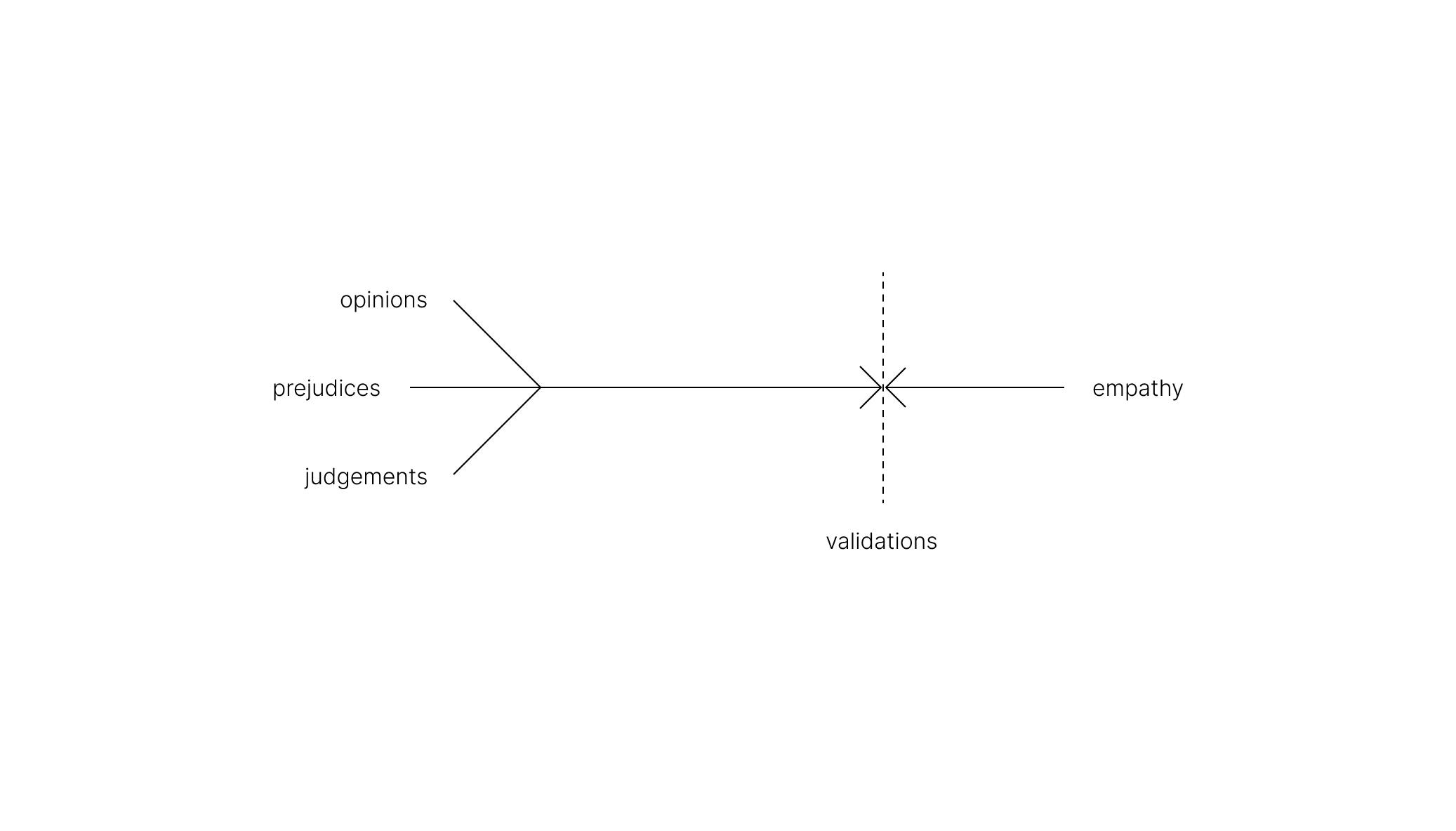Exercising validations to keep grounded - a philosophic undertaking (on the power of empathy and validation in design)

Opinions have the power to change the course of history. They help people, and very well hurt them too. Personal beliefs engine opinions as there is no pre-requisite for the base facts or knowledge behind those beliefs. So, everybody’s got one of these.
Thoughts run; opinions pop.
And that’s fine. Shouldn’t it be? It’s the basic nature and right of humans to express themselves.
But this freedom of expression doesn’t come equal to everyone. It develops over time. Some are able to express themselves and their opinions effortlessly. They tend to believe that they know what they are talking about and have the innate confidence to render a voice to their thoughts. While others might face anxiety and the pressure of the worldly judgements, self-conscience and tend to keep their thoughts to themselves. This is just the two ends of the behavioural spectrum, just imagine how complicated it’ll be when the external factors start weighing in. That said, one is not better off the other.
The premise — Everyone judges everyone else, whether that judgement is loud or muted, it depends on the individual. We are all taught to not judge a book by its cover. But, mostly unknowingly, we tend to do the exact opposite. And that’s fine too because in this case, the difference in what humans think they do and what they actually do is borne out of personal beliefs — opinions surfacing from the first looks.
When judgements age, they consolidate; leaving hardly any room for re-consideration, rather mostly affiliating into principal-led delusions. Time tends to echo the same old preconceived notions, if left unchecked. And the human nature takes the simple route of taken-for-grantedness.
Now everything stated above assumes that the emotional empathy is near zero.
Empathy is the philosopher’s stone of this whole construct of prejudice. It changes everything but for the better. Beliefs though still could lack knowledge of the facts but they become emotionally intelligent. And if the groundwork is right, everything else — opinions, judgements, delusions become humane.
Now that we have gained a brief background on the thought-maturity cycle, let’s talk about how this affects us — The way we receive criticism/evaluation/feedback/comment, constructive or not, is something we don’t have control over. What feelings or sense of emotions they strike depends on the scenario. Receiving a feedback in the middle of a meeting can serve very differently than when it’s talked through in private. But we can control their validation.
The power of validation becomes boundless. It could render any notion useless or make it a guiding principle. When thoughts are projected at us, either positive or negative, we should avoid taking them word-to-word. Rather, we should break them down, try to analyse the different situations, different cases that might have led to the formation of that idea we just heard. It might take more effort, be quite slow, but it’s insightful. It could help us be more receptive to better changes. It makes us better thinkers, and keeps us grounded.
Particularly for young designers, it’s very important to get around and digest this idea. We don’t necessarily have to develop a thick skin to bear criticism. But mere learn to absorb what other has to say, analysing its actual value before taking it to heart. Or if one could already care less about it, then that’s a different problem — that valley of ignorance just makes it harder to make it to the other side.
As designers it’s our job to be empathetic — and one way to do it is by questioning and validating everything that is put forward to us, trying to understand the prospective “why” behind it; be it a feature in the product, or user interview, or personal opinions. This method of thought-inspection helps in conducting qualitative User Research better — once we interact well with the users, get to know them, we could get rough ideas around the behavioural patterns(after a few interview sessions), these ideas can then help in reasoning out the observations from the interviews. And this could potentially be used in refining the user personas.
Developing this idea of exercising and therefore wielding validations— Designers are picky about everything. Ah, how we(or at least myself) spend hours just picking that shade of beige and still it is not good enough a suitor. We judge and suffer the judgement. It’s important for us to understand this construct. So that at the very least we know what we ought to be interacting with others. It could even help your personal life.
Design helps us to grow emotionally.

Validation seeks out the agreement or disagreement between two arguments, mapping the accountability of one against another. To decide on what these arguments should be is a tough job. But like everything else, it gets easier with time, practice and our ability to judge while considering emotions. Not all judgements are harmful.
Human race could use more empathetic behaviour.
If you’ve made it till here, you can try replacing “designer” with your profession. I’m pretty sure that it won’t lose the essence of the being. It’s simply just how humans behaviour should be with empathy. Let’s try to exercise it because it could make us better at our jobs, at life in general.
—
“If you have an idea, that you genuinely think is good, don’t let some idiot talk you out of it” — Stan Lee at UCLA Keynote graduation speech, 2017.
—
Note — This article takes a retrospective approach to the writing. The notes on the various parts of the thought-maturity cycle and how to carefully process them mostly come from my personal experience. You might feel different about them, and that’s fine. If you’d like, hit me up and let’s discuss.

